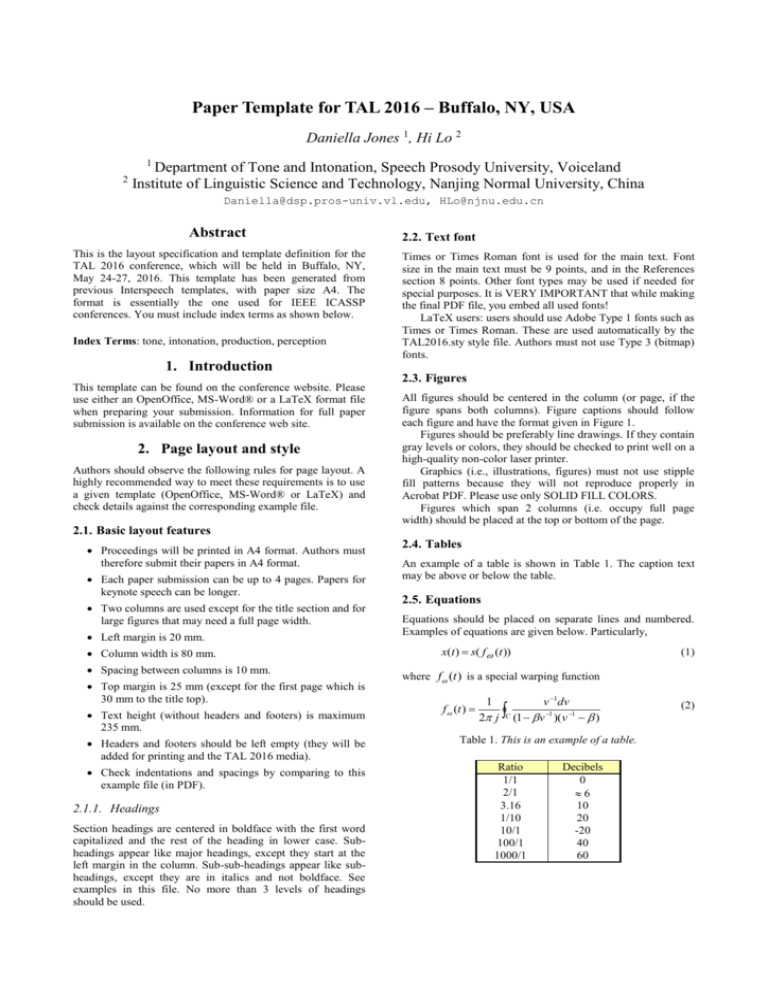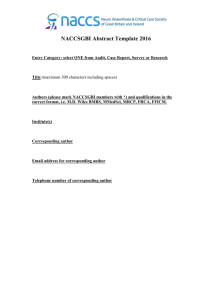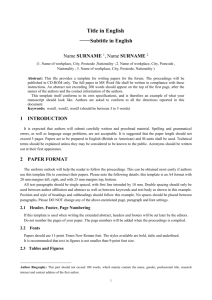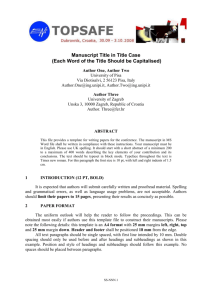TAL2016full_paper_WO..
advertisement

Paper Template for TAL 2016 – Buffalo, NY, USA Daniella Jones 1, Hi Lo 2 1 2 Department of Tone and Intonation, Speech Prosody University, Voiceland Institute of Linguistic Science and Technology, Nanjing Normal University, China Daniella@dsp.pros-univ.vl.edu, HLo@njnu.edu.cn Abstract This is the layout specification and template definition for the TAL 2016 conference, which will be held in Buffalo, NY, May 24-27, 2016. This template has been generated from previous Interspeech templates, with paper size A4. The format is essentially the one used for IEEE ICASSP conferences. You must include index terms as shown below. Index Terms: tone, intonation, production, perception 2.2. Text font Times or Times Roman font is used for the main text. Font size in the main text must be 9 points, and in the References section 8 points. Other font types may be used if needed for special purposes. It is VERY IMPORTANT that while making the final PDF file, you embed all used fonts! LaTeX users: users should use Adobe Type 1 fonts such as Times or Times Roman. These are used automatically by the TAL2016.sty style file. Authors must not use Type 3 (bitmap) fonts. 1. Introduction This template can be found on the conference website. Please use either an OpenOffice, MS-Word® or a LaTeX format file when preparing your submission. Information for full paper submission is available on the conference web site. 2. Page layout and style Authors should observe the following rules for page layout. A highly recommended way to meet these requirements is to use a given template (OpenOffice, MS-Word® or LaTeX) and check details against the corresponding example file. 2.3. Figures All figures should be centered in the column (or page, if the figure spans both columns). Figure captions should follow each figure and have the format given in Figure 1. Figures should be preferably line drawings. If they contain gray levels or colors, they should be checked to print well on a high-quality non-color laser printer. Graphics (i.e., illustrations, figures) must not use stipple fill patterns because they will not reproduce properly in Acrobat PDF. Please use only SOLID FILL COLORS. Figures which span 2 columns (i.e. occupy full page width) should be placed at the top or bottom of the page. 2.1. Basic layout features Proceedings will be printed in A4 format. Authors must therefore submit their papers in A4 format. Each paper submission can be up to 4 pages. Papers for keynote speech can be longer. Two columns are used except for the title section and for large figures that may need a full page width. Left margin is 20 mm. Column width is 80 mm. Spacing between columns is 10 mm. Top margin is 25 mm (except for the first page which is 30 mm to the title top). Text height (without headers and footers) is maximum 235 mm. Headers and footers should be left empty (they will be added for printing and the TAL 2016 media). Check indentations and spacings by comparing to this example file (in PDF). 2.1.1. Headings Section headings are centered in boldface with the first word capitalized and the rest of the heading in lower case. Subheadings appear like major headings, except they start at the left margin in the column. Sub-sub-headings appear like subheadings, except they are in italics and not boldface. See examples in this file. No more than 3 levels of headings should be used. 2.4. Tables An example of a table is shown in Table 1. The caption text may be above or below the table. 2.5. Equations Equations should be placed on separate lines and numbered. Examples of equations are given below. Particularly, x(t ) s( f (t )) (1) where f (t ) is a special warping function f (t ) 1 v 1dv C (1 v 1 )( v 1 ) 2 j Table 1. This is an example of a table. Ratio 1/1 2/1 3.16 1/10 10/1 100/1 1000/1 Decibels 0 6 10 20 -20 40 60 (2) 2.10. Abstract The total length of the abstract is limited to 400 words. The abstract included in your paper and the one you enter during web-based submission must be identical. Avoid non-ASCII characters or symbols as they may not display correctly in the abstract book. 2.11. Author affiliation Please list country names as part of the affiliation for each country. 2.12. Figure 1: Schematic diagram of speech production. A residue theorem states that F ( z)dz 2j Re sF ( z), p C k (3) k Applying (3) to (1), it is quite straightforward to see that 11 (4) Finally we have proven the secret theorem of all speech sciences. No more math is needed to show how useful the result is! 2.6. Hyperlinks For technical reasons, the proceedings editor will strip all active links from the papers during processing. Hyperlinks can be included in your paper, if written in full, eg. "http://www.foo.com/index.html". The link text must be all black. Please make sure that they present no problems in printing to paper. 2.7. Multimedia Files The TAL 2016 organizing committee offers the possibility to submit multimedia files. These files are meant for audio-visual illustrations that cannot be conveyed in text, tables and graphs. Just like you would when including graphics, make sure that you have sufficient author rights to the multimedia materials that you submit for publication. The proceedings media will NOT contain readers or players, so be sure to use widely accepted file formats, such as MPEG, Windows WAVE PCM (.wav) or Windows Media Video (.wmv) using standard codecs. The files you submit will be accessible from the abstract cards on the media and via a bookmark in the manuscript. From within the manuscript, refer to a multimedia illustration by its filename. Use short file names without blanks. Authors are requested to submit PDF files of their manuscripts. You can use commercially available tools or for instance http://www.pdfforge.org/products/pdfcreator. The PDF file should comply with the following requirements: (a) there must be no PASSWORD protection on the PDF file at all; (b) all fonts must be embedded; and (c) the file must be text searchable (do CTRL-F and try to find a common word such as 'the'). The proceedings editors will contact authors of non-complying files to obtain a replacement. In order not to endanger the preparation of the proceedings, papers for which a replacement is not provided timely will be withdrawn. 3. Discussion This is the discussion. This is the discussion. This is the discussion. Is there any discussion. This is the next paragraph of the discussion. And the last sentence of it. 4. Conclusions Authors must proof read their PDF file prior to submission to ensure it is correct. Authors should not rely on proofreading the Word file. Please proofread the PDF file before it is submitted. 5. Acknowledgements The TAL 2016 organizing committee would like to thank the organizing committee of TAL 2014 for their help and for kindly providing the template files. 6. References [1] [2] [3] 2.8. Page Numbering Page numbers will be added later to the document electronically. Don't make any footers or headers! 2.9. References The reference format is the standard IEEE one. References should be numbered in order of appearance, for example [1], [2], and [3]. Submitted files Smith, J. O. and Abel, J. S., “Bark and ERB Bilinear Transforms”, IEEE Trans. Speech and Audio Proc., 7(6):697-708, 1999. Soquet, A., Saerens, M. and Jospa, P., “Acoustic-articulatory inversion”, in T. Kohonen [Ed], Artificial Neural Networks, 371-376, Elsevier, 1991. Stone, H. S., “On the uniqueness of the convolution theorem for the Fourier transform”, NEC Labs. Amer. Princeton, NJ. Online: http://citeseer.ist.psu.edu/176038.html, accessed on 19 Mar 2008.




